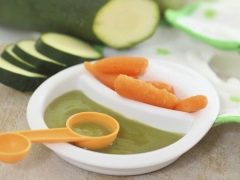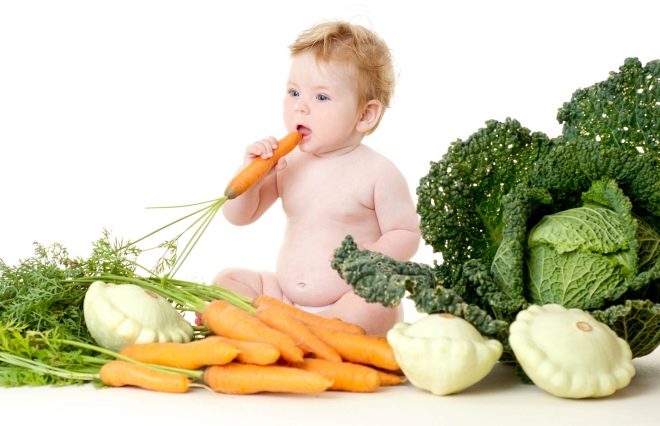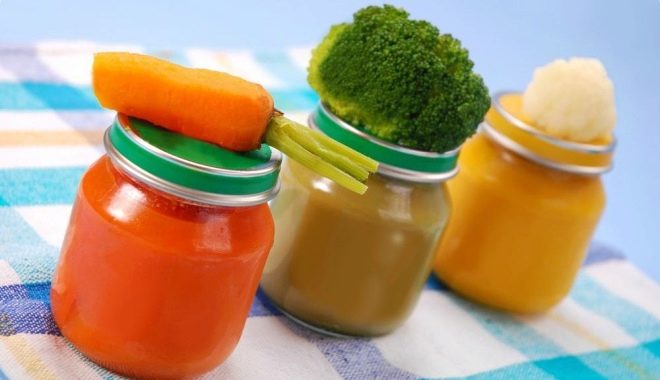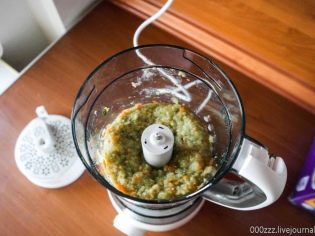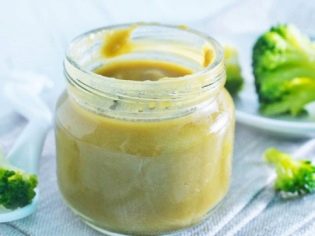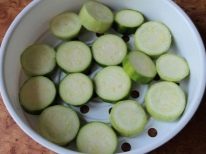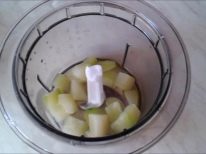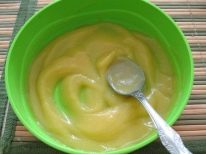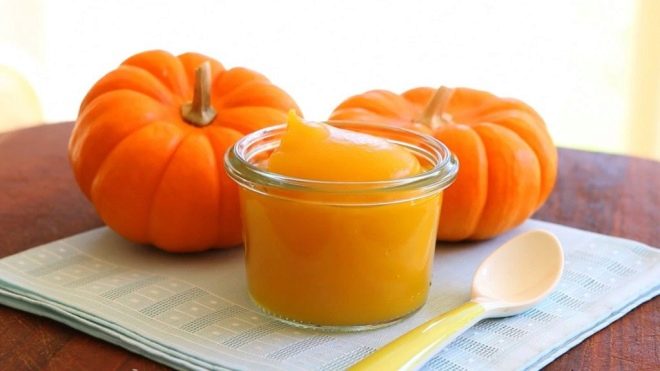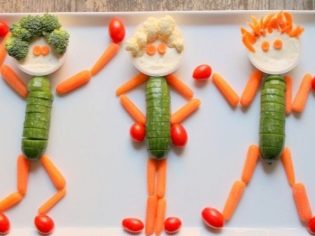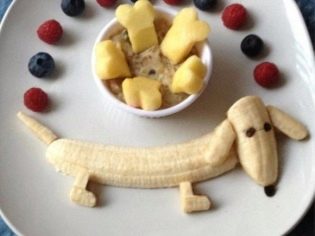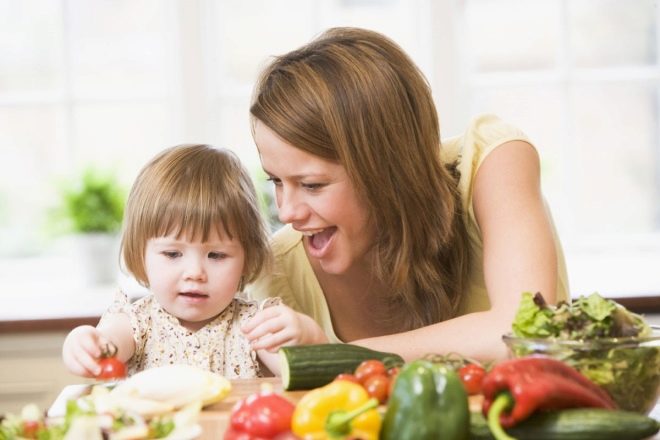Vegetables for children: properties, introduction to the diet and recipes of dishes
The benefits of vegetables in baby food is difficult to overestimate, unless, of course, we are not talking about syroedenie or vegetarianism. The more varied baby food, the better for the health of the baby.
Are all vegetables so useful, which ones and how to feed babies and how to teach a child to love vegetable dishes, we will tell in this article.
Benefit and harm
Vegetables, like any other products, are good and useful for children when they are given on time, in the right quantity. Overabundance of vegetables, the early introduction of such complementary foods, vegetable "skew" in the diet of the child can not be beneficial under any circumstances.
To meet the needs of the child in fats, proteins and carbohydrates vegetables can not. But can supplement the diet with vitamins and minerals. Another advantage of vegetable dishes - the abundance of plant fiber, which plays an important role for the digestive system. Cellulose promotes softer digestion of food, its assimilation, and also is an excellent prevention of constipation.
Plant fiber helps to eliminate toxins from the child’s body, from which in our time nowhere to hide. Almost all vegetables and fruits possess the properties of natural antioxidants. Vitamins in the composition of vegetables - an excellent help for children's immunity, its nervous system. Useful properties of vegetables depend on their specific type.
If your child needs vitamin A, you should pay attention to carrots, peas, potatoes and beans. In search of vitamin D should pay attention to the cabbage and potatoes. Vitamin E for skin and immunity is found in greens, asparagus, peas, broccoli and green lettuce. Vitamin C in fairly large quantities can be found in cabbage, potatoes, green lettuce, as well as in beautiful red and yellow Bulgarian peppers.
However, the composition of vegetables may be allergenic. All, of course, depends on the age and individual characteristics of the health of the child, but it will be useful to familiarize yourself with the list of allergenic and hypoallergenic vegetables. The second - the choice of the first stage, that is you must begin to introduce vegetable dishes with hypoallergenic gifts of nature, which include zucchini, cabbage, cucumbers, onions, a little later potatoes will be added to them.
Peas, pumpkin are products of moderate allergenicity. But tomatoes, asparagus, carrots and beets may well cause inadequate reaction immunity, which does not slow down to appear rash or another form of allergy. However, proper and timely addition of such vegetables will help avoid negative consequences.
In the child's diet should be raw vegetables, and the dishes in which they were subjected to heat treatment. The opinion that nutrients are stored only in fresh vegetables is erroneous and inaccurate. Proper preparation will provide the child with a healthy and full-bodied dish.
Prikorm - rules and requirements
It is vegetable puree that is considered the best first baby food. Pediatricians believe that for a baby being breastfed, The best time for introduction of such complementary foods will be 6 months. If the child is on artificial feeding, then you can give vegetable puree in 4-5 months.
Properly chosen puree will surely please the baby, because it is at least a new taste for it. In addition, vegetables in the diet of infants weak intestines of the infant, due to which it is possible to quickly defeat such an urgent and common problem as constipation.
What vegetables can I give first? Of course, hypoallergenic. The best are mashed zucchini, broccoli, cauliflower, it is only important that the mash be single component, that is, consisted of one type of vegetables. These vegetables do not create a serious load on the digestive tract.
About a month after the introduction of the first feeding you can expand the baby’s menu - 5-6-month-old child can be given mashed pumpkin, with the addition of carrotsand also to prepare mashed potatoes.
A month later, add cabbage. In 1 year it's time to teach a baby to eat tomatoes and cucumbers; at the age of 2, the child should try all the vegetables that are natural for the strip in which he lives. Do not give exotic vegetables up to 3 years.
You need to start feeding with half a teaspoon. This applies to any vegetable at any age.
If during the day of observation mother does not notice signs of indigestion and allergy, then the next day you can increase the number of vegetable foods to a teaspoon, and then to two, and so on.
To teach a child to eat vegetables is easiest in the first year of life. If you do not do this in a timely manner, it will be difficult for a one-year-old baby and older to inculcate a love for carrots and cabbage.
For prikorma, you can use hypoallergenic baby puree. A little later, when the baby starts to eat vegetables, mashed potatoes can be prepared independently. For an infant who needs only 1-2 spoons of a vegetable dish, it will be difficult to cook every day a fresh mashed potatoes. therefore experienced moms recommend cooking mashed potatoes after the portion has been increased to a substantial amount.
The finished canned mash has its advantages - it makes it easier for the young mother (she has enough of the zucchini mash and has enough worries!), It is convenient to take it with you for a walk or a trip so that the child can eat at any time; mashed potatoes factory production sterile, its composition matched perfectly. But there are advantages to the homemade dish: Mom is calm, as she feeds the child with natural, with what she chooses and cooks herself.
How to cook on your own?
For home cooking children's meals try choose only fresh, uncorrupted, good looking vegetables, no dents, blemishes or dark spots. Best of all, if they are collected from their own cottage or garden. If there is no land for growing vegetables, buy the fruits that are grown in your area and correspond to the season.
Squashes in winter are usually imported, and chemicals are used to transport them; Often they fertilize vegetables intended for export so that they keep their presentation longer. If it's winter and the courgettes in your area do not grow at that time, it is better to give preference to canned baby puree as the first complementary food.
From the kitchen equipment you need a blender, well, if there is a double boiler.
The recipes for vegetable puree are pretty simple. Wash and clean the vegetable, cut into large chunks (so it will save more vitamins during heat treatment), cook in a double boiler or cook without salt and spices in a small amount of water. Put the finished pieces in a blender and grind. You can mash with a drop of olive oil. If you get too thick mashed potatoes, you can add a little vegetable broth or boiled water.
It is important every time before eating to cook a new mashed potatoes. It is strongly not recommended to keep it.
A child must make a varied vegetable menu from year to year. It can be vegetable soups, including puree soups, it can be stewed vegetables, fresh vegetables, salads with boiled and fresh vegetables. Children like beautiful and tasty vegetable desserts, for example, pumpkin mousse.
To make it, take 300-500 grams of peeled pumpkin pulp, bake in the oven or boil, pass through a blender with a small amount of cottage cheese. You can add a little sugar, and you can do without it, because the pumpkin turns out pretty sweet. Ready beautiful sunny mousse can be served as a separate dish, for example, in the mid-morning snack, and as a set meal for a child.
If the child refuses
If a child refuses vegetables, he always has a good reason. Either he was forced to eat vegetables, shoved him with spoons against his will, or he was afraid of new tastes or just got used to sweets and juices as a complementary food, so the fresh taste of vegetables without salt and spices would seem to him tasteless.
Also, a child can refuse vegetables due to the fact that he is tired of monotony or dishes made from them look unappetizing.
It should be understood that the child should not owe anything to anyone, including he should not eat vegetables that are disgusting and uninteresting to him. The best thing parents can do is to interest the child in vegetable dishes. Making them eat is the right way to nowhere. The child will hate the pumpkin and zucchini even more.
Try to follow these guidelines.
Choose a vegetable, which is proposed to eat, already with a year old child must himself. Offer him a choice of cauliflower or zucchini, squash or pumpkin. It will be his choice, and, believe me, even the youngest children greatly value it.
To teach a child to eat vegetable dishes, if he refuses, it is possible with a few tricks and frank parental deception - chop, rub on a grater, mash the vegetable and add to the food that the baby eats with pleasure. So do not have to argue and prove. At the same time, the baby will receive vegetables and all the vitamins from them, besides, he will gradually get used to their taste, without even giving himself this report. Then, when he gets older, it will be easier to offer already open vegetable dishes.
Do not force your child to eat vegetable puree or drink vegetable juice. If he doesn’t want, there is no need to do anything by force.
Big mistake to offer a child a deal like “I ate a vegetable - get sweetness”. Even if he makes an effort over himself, then after receiving the promised sweet reward, he will perfectly feel the contrast of taste, and obviously will not add to the vegetables of love.
Offer vegetables at the very beginning of the meal when the baby is hungry.
Do not be lazy and cook vegetables beautifully. Collect colorful pictures of them on a plate - cut out a thin figure knife or with special nozzles asterisks and figurines from ordinary carrots or tomatoes to eat a vegetable dish was interesting.
- It is not necessary to force the child to eat fresh vegetables after he turns 1.5-2 years old. If the baby does not suffer from allergies, add a small amount of salt and spices to them, then the taste will be more attractive for a son or daughter.
A child who himself, with his own hands, helped prepare dinner or helped decorate it, is unlikely to refuse to try it.
Come up with stories and fairy tales in which the main characters will be vegetables.
Replace all the snacks and pieces that children during the day love to grab from the table with pieces of fresh vegetables. It will be both useful and pleasant.
How to make baby mash for the first feeding, see the following video.
